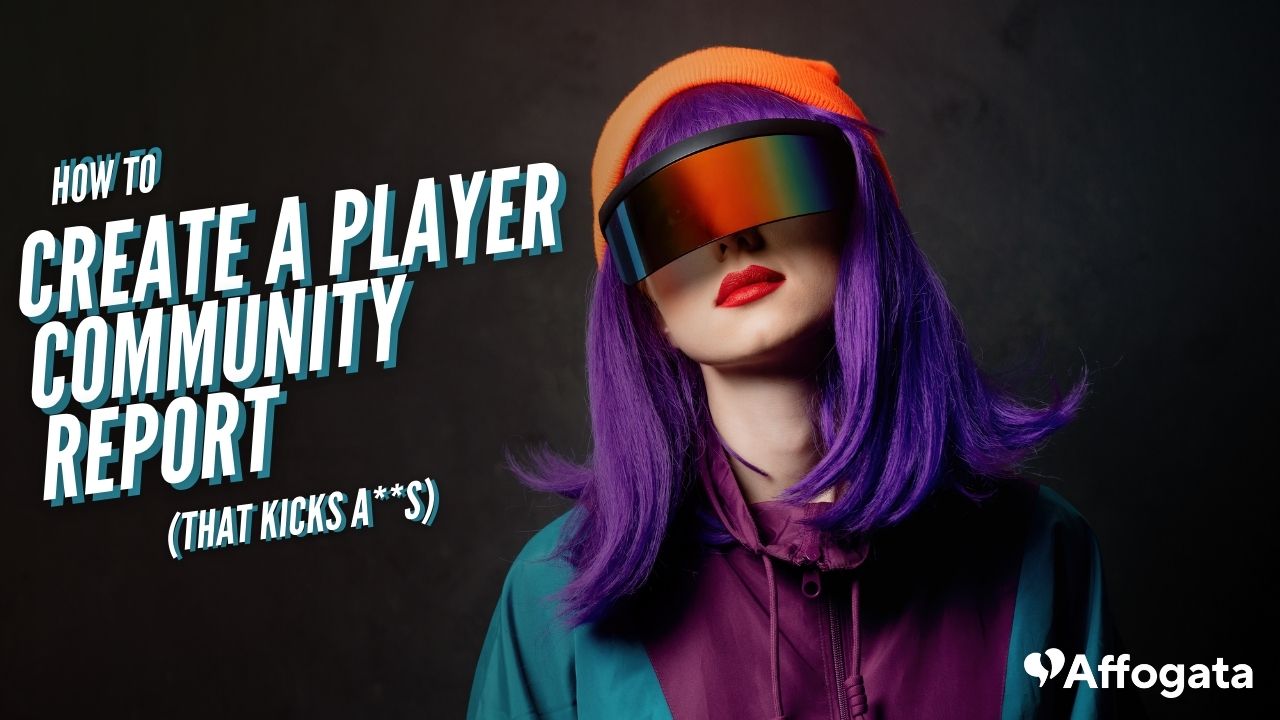Every player-facing team knows: there are many challenges that come with managing big player communities. There’s a lot of power in the voice of the player, but also plenty of knowledge that can be used to improve the game, benefiting the studio and ultimately back to creating a better player experience. So it’s a data race, right? Studios have become masters of knowing “what happened” – and by that we mean analyzing player demographic data, gameplay data, in-app purchases, LTV, player churn and so on.
But the picture is never complete unless studios figure out what their players think about their games, and that can only be achieved by analyzing their player feedback from every source. That, ladies and gentlemen, covers the “why something happened”. And that’s a whole data world by itself.
Product, design, live-ops and other teams are constantly releasing new features, activities, levels, characters and even new games! And who are the heroes in the front passing on the cheers or dealing with the feedback? You guessed it right! Player community managers, player support managers and everyone in between are regularly requested to know “what players think about something”. In the past, the gesture of licking your index finger and putting it up in the air to understand the direction of the wind had more science to it than the ways player facing teams had to quantify and qualify the feedback from their player communities.
Today, AI-Driven technologies and superior sentiment analysis engines empower community teams and player support teams to better understand how players feel about everything the studio releases. But it doesn’t stop there, because only understanding better the player community feedback is not actionable on itself. Today, these technologies also allow player-facing teams to better report the voice of the players to other teams in the organization. Teams that can take action and make changes to the games to give the players a better experience.
Player community reports circulate throughout studios and their readers vary from heads of studio, to producers, live-ops teams, designers and more. So how do you create a report that helps you truly represent the voice of the player community? What are the key elements of such a report? And how to create it in a manner which would present a clear picture for so many stakeholders?
You got to the right place, keep reading!
What data do you need to create a player community report?
To create a player community report that gives the studio stakeholders a crystal clear picture of the player community feedback, you will need various data sets that can provide you with insights into player behavior, preferences, and engagement. Here are some of the data sets you might need:
1. Player feedback data: This includes information about player feedback on your game, which can come from internal sources such as social media, app store reviews, Steam, Vanilla, Discord, to name a few; and internal feedback data sources like studio forums or ticketing systems like Helpshift.This data will help you understand player sentiment and identify areas of the game that players are particularly happy or unhappy with.
2. Player community engagement data: This includes information about how players are engaging with each other and the game’s community. This can include data on forum activity, social media engagement, toxicity and more. This data will help you understand how players are interacting with each other and how engaged they are with the game and its community.
By combining these data sets and analyzing them, you can create a comprehensive player community report that provides insights into player behavior, preferences, and engagement. This can help you identify areas for improvement, optimize the game’s features and content, and improve the overall player experience.
How do you collect player feedback data?
After understanding what data you need for the report, the next step is finding it. The data set you use is the heart of the report. It will indicate what engages players and how they behave in order to get the full picture. You can collect the data a few ways: 1. Manually gather data from internal sources: While this process can be time consuming, it’s also thorough. Checking all sources allows you to never miss a comment that could be crucial to your data set.
2. Use an AI-Driven Analyst: An alternative to manual data collecting, is using an AI driven tool, such as ours, Affogata Helper. Affogata helper allows you to get meticulous data sets, for every topic you look into.
Helper is designed so you can ask a question about your player feedback data and it will reply with an answer, finding you the data you need in seconds, allowing you to go from a qualitative to a quantitative understanding of your player feedback effortlessly.
Once you have gathered all this data, you can start putting together the structure of your report.
How to structure a player community report?
The structure of a player community report for a game may vary depending on the specific goals and objectives of the report. However, here is a general framework that can be used to structure a player community report:
1. Executive summary: This section should provide a brief overview of the report’s main findings and conclusions. It should highlight the key takeaways and recommendations for the game’s development team or other stakeholders. Here you can include a screenshot or two including player feedback that represent your key takeaways.
2. Introduction: This section should provide background information on the game, its target audience, and the objectives of the report. It should explain the scope and methodology used to collect and analyze the data.
3. Player Demographics: This can be a redundancy if you work for a studio with one game or few games, in that case most team members will be very familiar with who the players are. If you work for a multi-game studio, this section would give a better background to understand the player feedback and more. It should present demographic data available on the game’s player base, including age, gender, location, and other relevant characteristics. It should also include any trends or patterns observed in the data.
4. Player Feedback: This section should present player feedback data from all the sources we described above. Here, you can also include a breakdown quantifying and qualifying the feedback. Meaning showing the amount of feedback you collected and then dividing it by either positive, negative or neutral. You can also split the feedback into well-defined categories or labels, to enable stakeholders to see which topics are more popular for their player community and which are the least favorites. In this section, you can also compare current player feedback quantities with those of a previous time frame, in order to examine improvement or failure to improve.
5. Community Engagement: This section gives you the opportunity to highlight any notable community events or initiatives. Player Feedback Analytics platforms give you the ability to match a spike in player comments, be it positive or negative, with specific actions from the studio, such as introducing a game update, a live-ops event or a change in pricing. Also, this is the report section where you can report toxicity in your community.
6. Competitor Analysis: Only if it’s relevant to the report you’re creating. Examining a game’s player community feedback against one or more competing games can help the studio’s stakeholders better understand the game’s position in the market, what competitors are doing right, and what they are doing wrong.
7. Conclusion: This section should summarize the main findings and conclusions of the report. It should highlight any areas of the game that need improvement, as well as any opportunities for growth or further development.
8. Recommendations: This section should provide specific recommendations for the game’s development team or other stakeholders based on the findings of the report. It should include actionable steps to improve the game’s features, content, and community engagement.
9. Appendices: This section should include any additional data or information that was not included in the main report but may be relevant to the game’s development team or other stakeholders. This could include raw data sets, methodology details, or other relevant documents.
Remember: Images speak louder than words!
If you can, say it with a graph, do it! – AI-Driven Player Feedback Analytics platforms (Ahem like our very own) will allow you to, not only collect the feedback, but also to showcase it in a crystal clear way.
Overall, presenting data in a visually pleasing way can help to improve the effectiveness of a player community report by making it easier to read and understand, encouraging engagement with the data, improving credibility, and building brand recognition.
Some examples of slides you can include in your report:
1. Showing player feedback changes according to events
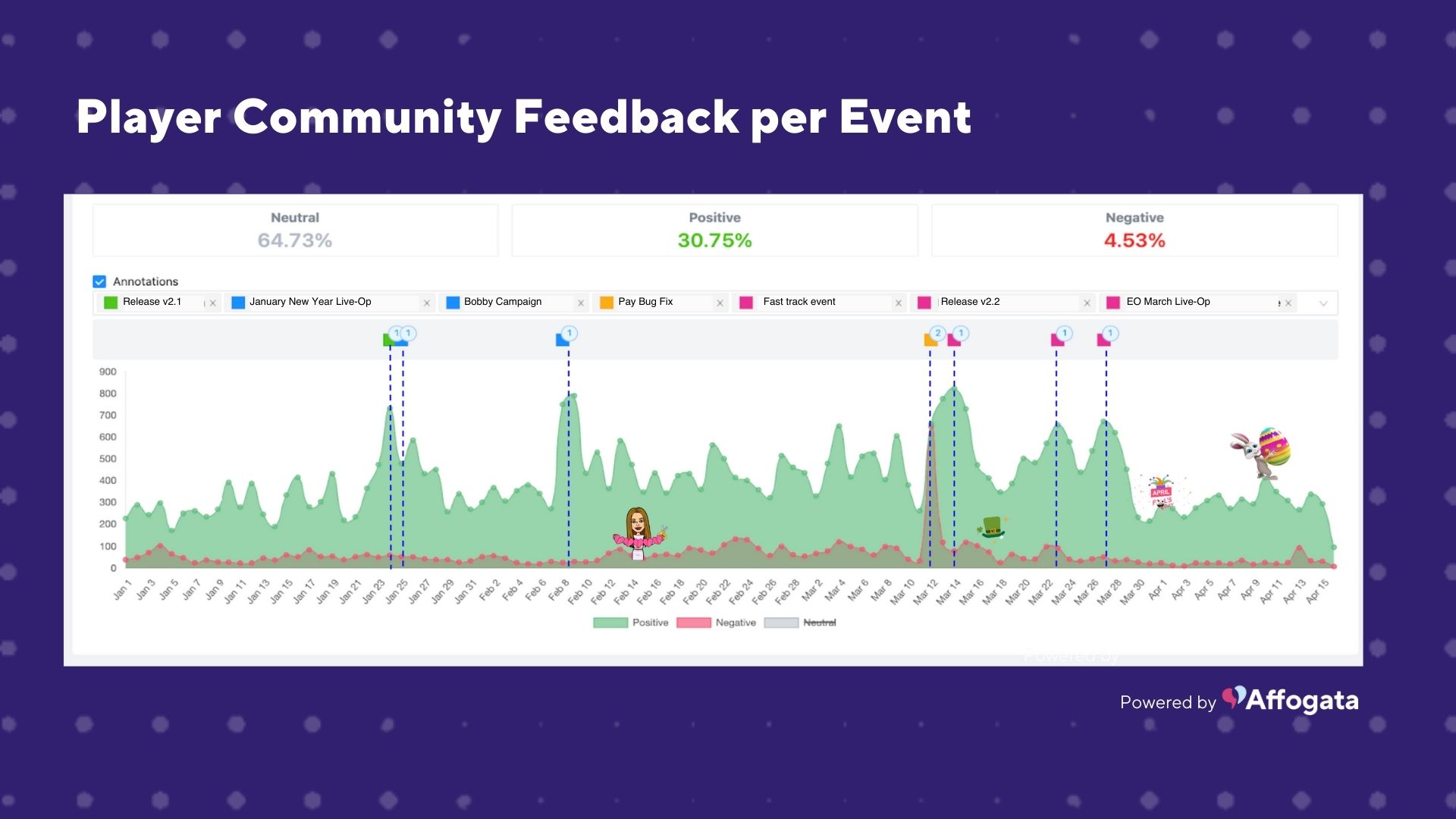
2. Most popular topics (based on keywords) showing trends and sentiment
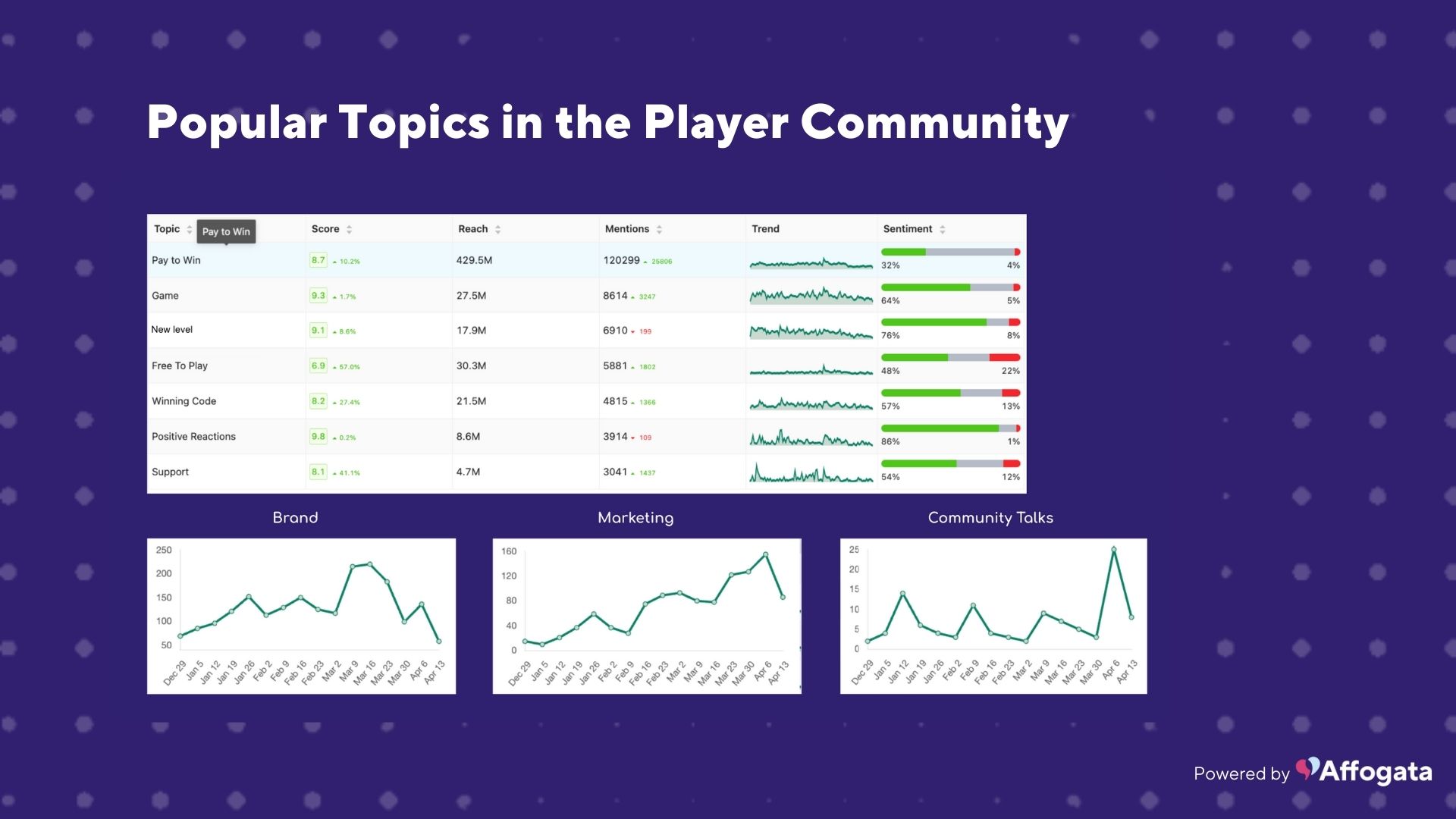
3. Changes on a specific feedback channel over time
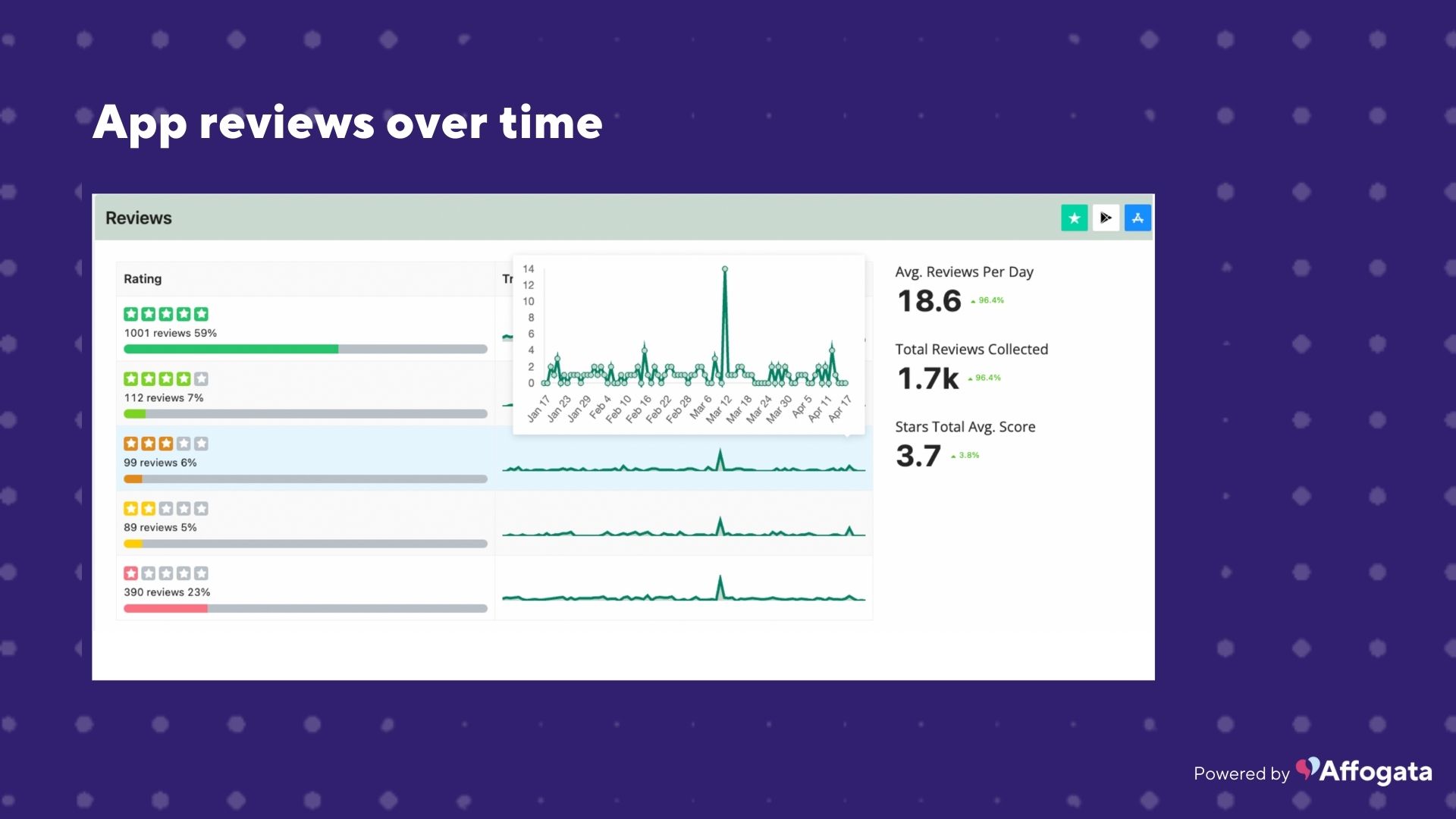
4. Comparing the performance of two different games in all feedback channels
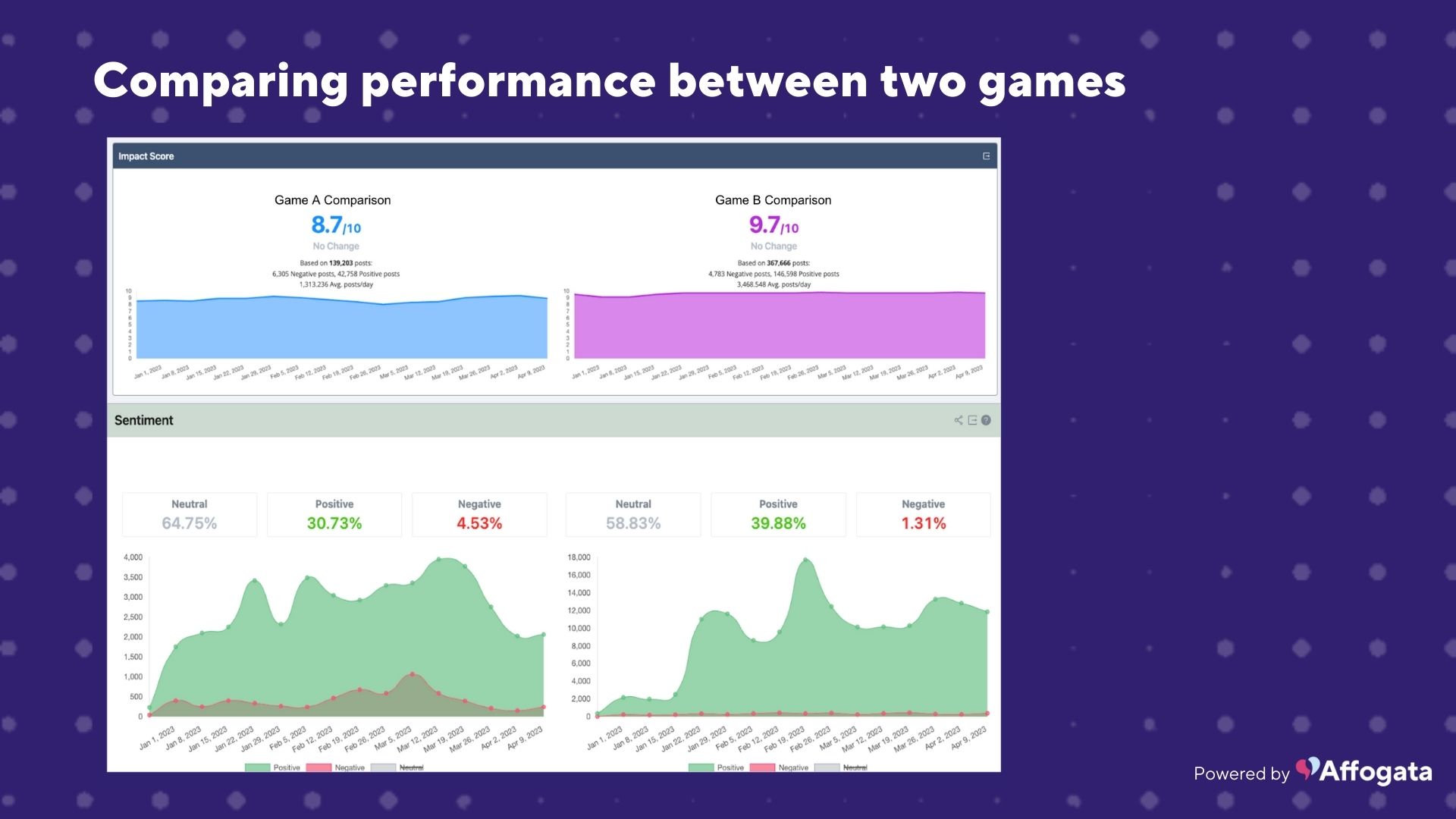
And so much more!
A player feedback report helps a gaming studio examine the reasons for its player community’s behavior, serving as a crucial part in understanding the performance of studio games.
The player community is the heart of your studio, they are the ones who play, engage and pay for the games your team creates. Without players, there would be no market for what we do. Player community managers and player support managers are the pros in the front line, listening, monitoring and dealing with the player community feedback. Becoming a pro in reporting their voice to the many stakeholders in the studio can really boost yours and your teams impact in the game making processes.
We hope this article helped! If you still don’t use an AI-Driven Analytics Platform in your studio, talk to us.
